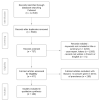Uterine Factor Infertility, a Systematic Review
- PMID: 36013146
- PMCID: PMC9410422
- DOI: 10.3390/jcm11164907
Uterine Factor Infertility, a Systematic Review
Abstract
Uterine factor infertility (UFI) is defined as a condition resulting from either a complete lack of a uterus or a non-functioning uterus due to many causes. The exact prevalence of UFI is currently unknown, while treatments to achieve pregnancy are very limited. To evaluate the prevalence of this condition within its different causes, we carried out a worldwide systematic review on UFI. We performed research on the prevalence of UFI and its various causes throughout the world, according to the PRISMA criteria. A total of 188 studies were included in qualitative synthesis. UFI accounted for 2.1 to 16.7% of the causes of female infertility. We tried to evaluate the proportion of the different causes of UFI: uterine agenesia, hysterectomies, uterine malformations, uterine irradiation, adenomyosis, synechiae and Asherman syndrome, uterine myomas and uterine polyps. However, the data available in countries and studies were highly heterogenous. This present systematic review underlines the lack of a consensual definition of UFI. A national register of patients with UFI based on a consensual definition of Absolute Uterine Factor Infertility and Non-Absolute Uterine Factor Infertility would be helpful for women, whose desire for pregnancy has reached a dead end.
Keywords: absolute uterine factor infertility; acquired uterine dysfunction; congenital uterine dysfunction; non-absolute uterine factor infertility; uterine factor infertility.
Conflict of interest statement
The authors declare no conflict of interest.
References
-
- Assistance Médicale à la Procréation (AMP) Inserm-La Science Pour la Santé n.d. [(accessed on 7 August 2019)]. Available online: https://www.inserm.fr/information-en-sante/dossiers-information/assistan....
-
- Akhter S., Alam H., Khanam N.N., Zabin F. Characteristics of infertile couples. Mymensingh Med. J. 2011;20:121–127. - PubMed
-
- Brännström M., Johannesson L., Dahm-Kähler P., Enskog A., Mölne J., Kvarnström N., Diaz-Garcia C., Hanafy A., Lundmark C., Marcickiewicz J., et al. First clinical uterus transplantation trial: A six-month report. Fertil. Steril. 2014;101:1228–1236. doi: 10.1016/j.fertnstert.2014.02.024. - DOI - PubMed
Publication types
LinkOut - more resources
Full Text Sources


